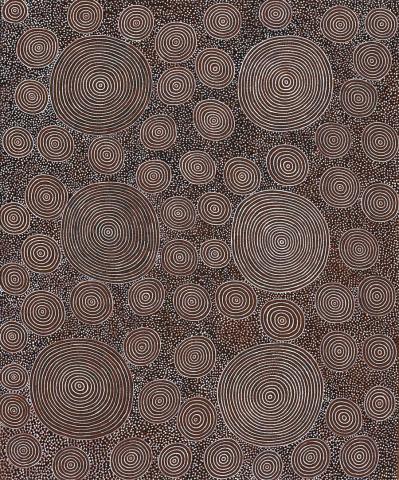TINGARI MEN'S TRAVELS FROM KULKUTATOWARD LAKE MACDONALD, 1990
Anatjari Tjakamarra
synthetic polymer paint on linen
182.0 x 152.0 cm
Papunya Tula Artists, Alice Springs (cat. AT900918)
Gallery Gabrielle Pizzi, Melbourne (label attached verso)
Private collection, Melbourne
Sotheby's, Sydney, 28 – 29 July 2003, lot 178
Private collection, United States of America
Aboriginal Paintings from the Desert: Paintings by Australian Artists from Papunya, Balgo Hills and Utopia, Union of Soviet Artists Gallery, Moscow, May – June 1991 and Museum of Ethnographic Art, St. Petersberg, November 1991 – January 1992
Pizzi, G., Aboriginal Paintings from the Desert: Paintings by Australian Artists from Papunya, Balgo Hills and Utopia, Gallery Gabrielle Pizzi, Melbourne, 1991 p. 47 (illus.)
Artist's country near Kurlkurta 1988, acrylic on canvas, 183.0 x 152.5 cm, in Morphy, H., and Smith-Boles, M., Art from the land: dialogues with the Kluge-Ruhe Collection of Australian Aboriginal Art, University of Virginia, 1999, p. 242 (illus.)
For a detailed analysis of the artist's early paintings in relation to his exploration of the mythological/ritual Tingari cycle see Myers, F.R., Painting Culture: The Making of an Aboriginal High Art, Duke University Press, Durham and London 2002, pp. 86 – 106 (referred to as Yantajari Tjakamarra)
Born in southern Pintupi country, Anatjari Tjakamarra was one of the last of his people to leave his traditional homelands. He was part of the original group of men painting at Papunya in 1971–1972 in Geoff Bardon's brief but pivotal tenure. A meticulous painter producing works of great precision and detail, Tjakamarra moved to Tjukurla in Western Australia in the early 1980s and was based there for most of the decade. In the late 1980s after a break from painting, Tjakamarra returned to paint for Papunya Tula Artists when he moved to Kiwirrkura and in 1989, had a solo show in New York from which the Metropolitan Museum in New York acquired a painting for its collection.
This large and important painting is the culmination of the artist's later depictions on the theme of the mythological Tingari Cycle, the rituals of which Tjakamarra was heavily involved.1 Curator Judith Ryan sees later Pintupi depictions of the Tingari as a tightly restricted visual language, where more sacred elements revealed in early works are masked or eliminated. The evolution of Tjakamarra's painting seems to confirm this view given that between 1973 and 1975 his experimentation with representations of the Tingari was so refined that his depictions became variations of large floating roundels. Unhindered by connecting lines and free from other iconography, set against either a bare background or one in-filled with fine variegated dotting, Ryan compares these later minimal works to being 'like cadences in a solemn Gregorian chant, where a limited number of colours and motifs are ritually repeated.'2
1. Myers, F.R., Painting Culture: The Making of an Aboriginal High Art, Duke University Press, Durham and London 2002, p. 86
2. Ryan, J., 'The mythology of Pattern; Papunya Tula Art 1971–1989' in Mythscapes; Aboriginal Art of the Desert from the National Gallery of Victoria, National Gallery of Victoria, Melbourne, 1990, p. 29
